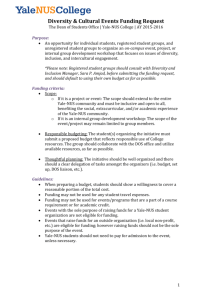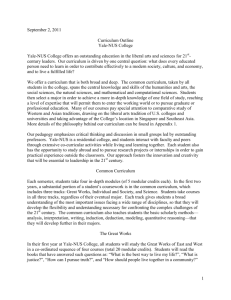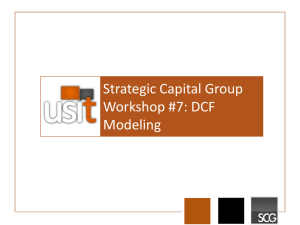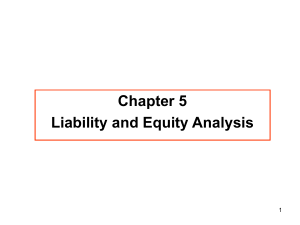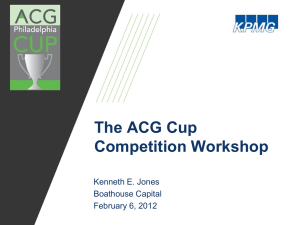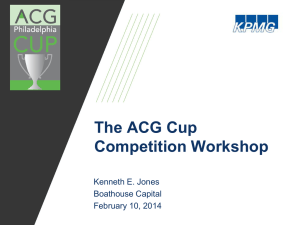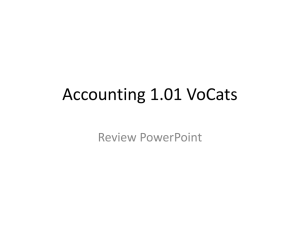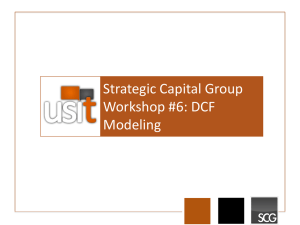Valuation Part 2
advertisement
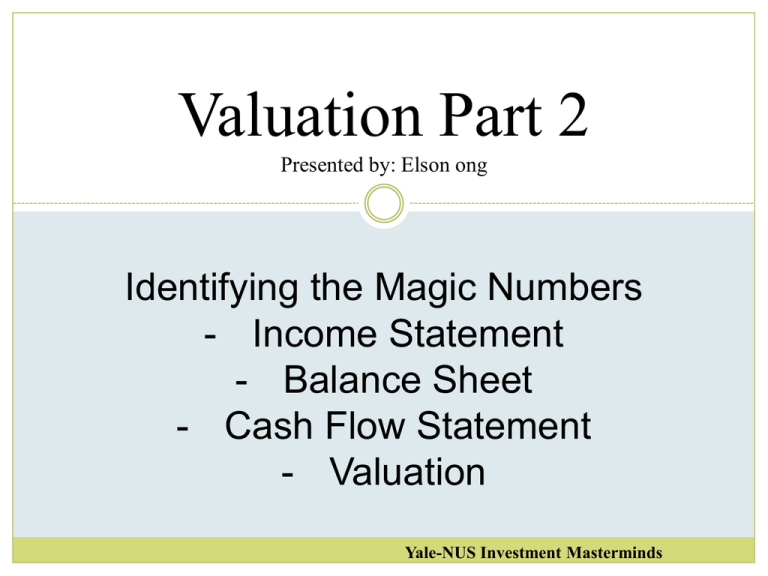
Valuation Part 2 Presented by: Elson ong Identifying the Magic Numbers - Income Statement - Balance Sheet - Cash Flow Statement - Valuation Yale-NUS Investment Masterminds Revision Revenue Profit and Loss Statement Stocks/Inventory Balance Sheet Current Liabilities Balance Sheet Trade Receivables/Debtors Balance Sheet Short Term Borrowings Balance Sheet Shareholders’ Equity Balance Sheet Net cash flows from operating activities Cash Flow Statement Fixed Assets Balance Sheet Yale-NUS Investment Masterminds Revision Gross Profit Profit and Loss Statement Cost of Goods Sold Profit and Loss Statement Current Assets Balance Sheet Cash and Cash Equivalent Balance Sheet Trade Payables Balance Sheet Long Term Loans Balance Sheet Reserves/Retained Earnings Balance Sheet Yale-NUS Investment Masterminds Income statement Earnings Per Share (EPS) EPS = Net Profit After Tax – Dividends on Preferred Stock/ Total Number of Common Shares Issued - Portion of a company’s profit allocated to each outstanding share of common stock - Serves as an indicator of a company’s profitability - Important to be aware of earnings manipulation - Compare with past years EPS - Compare with other companies of the same industry Yale-NUS Investment Masterminds Income statement Return on Equity (ROE) ROE = Net Profit after tax / Shareholders’ Equity - Measures profitability of the business attributable to shareholders - Measure of profitability for shareholders and reflects a combination of the company’s efficiency in generating profits from a) normal operations b) financing decisions c) tax policies Yale-NUS Investment Masterminds Income statement Return on Assets (ROA) ROA = Profit before interest and tax/ Total Assets - Measures operating profitability of the business that is independent of: a) How the company’s assets were financed (through debt or capital financing) b) Tax policies - Compared with ROA of similar companies in the same industry Yale-NUS Investment Masterminds Income statement Net Profit Margin/Gross Profit Margin Net Profit Margin = (Net Profit/Revenue)*100% Gross Profit Margin = [(Revenue - COGS)/Revenue]*100% - Calculates the profit margins for company’s products or services - Compare against industry peers - High gross profit margin indicate strong demand - Consistently High Net Profit Margins indicate possible competitive advantage/monopoly Yale-NUS Investment Masterminds Balance sheet Current Ratio/Cash Ratio Current Ratio = Current Assets/Current Liabilities Cash Ratio = Cash & Cash Equivalent/Current Liabilities - Calculates how liquid the company is and measures a company’s ability to meet its short term obligation - High current ratio (Eg: 2) indicate that a company is very liquid and has 2 times of current assets against current liabilities - High cash ratio means that the company has enough cash to pay off all their current liabilities Yale-NUS Investment Masterminds Balance sheet Inventory Turnover Inventory Turnover (days) = (Inventory*365 Days)/COGS Inventory Turnover= COGS/Inventory OR Sales/Inventory - Not applicable to all companies - The lower the inventory turnover the better because it means that the company takes lower/less time to sell their goods and get a replenishment (liquidity) Yale-NUS Investment Masterminds Balance sheet Debtor and Creditor Days Debtor (Trade Receivables) Days = (Trade Debtors*365 Days)/Revenue Creditor (Trade Payables) Days = (Trade Creditors*365 Days)/COGS - Compare the Debtor Days to the Creditor Days - If Creditor Days > Debtor Days, it means that the suppliers are funding the company rather than their customers Yale-NUS Investment Masterminds Balance sheet Debt to Income Ratio (DTI) DTI = Net Borrowings/Net Profits DTI = Net Borrowings/Operating Cash Flow - Might use Operating Cash Flow to see if the company’s cash flow is able to cover the company’s borrowings - High DTI means that there is more burden for the company to make payments to their debts Yale-NUS Investment Masterminds Balance sheet Gearing (Debt/Equity Ratio) Gearing = [(Total Borrowings – Cash)*100]/Shareholder’s Equity OR Gearing = (Total Liabilities*100)/Shareholder’s Equity - Ratio of other people’s money to your own money - Ratio of liabilities to shareholder’s money - If investing in highly geared companies, make sure that the cash flow is steady and consistent, such as power stations or telcos Yale-NUS Investment Masterminds Balance sheet Gearing (Debt/Equity Ratio) Limitations to the Firms Capacity to Push Leverage Too High: 1) Higher Borrowing Cost 2) Cost of Equity Rises 3) Difficulty maintaining ROA Yale-NUS Investment Masterminds valuation Market Capitalisation Market Capitalisation = Share Price*Number of Shares Outstanding - This means a low share price doesn’t mean that a company is “small” or “cheap” or a high share price doesn’t mean that a company is “big” or “expensive” Yale-NUS Investment Masterminds Valuation Dividend Yield/Dividends Per Share (DPS) DPS = Dividend per share/Price per share - How much a company pays out in dividends each year relative to its share price - Measure of return for investors in terms of dividends Yale-NUS Investment Masterminds Valuation Important things to take note: - No one indicators is perfect - Should look at all the magic number before making decisions Yale-NUS Investment Masterminds Valuation Considerations for investors when evaluating potential company 1) Existing Debt Level 2) Purpose of taking more Debt 3) Refinance old debts 4) Can Company Afford New Debt 5) Provisions in New Debt to force immediate payback Yale-NUS Investment Masterminds Valuation Part 2 Presented by: Elson ong Any Questions?
